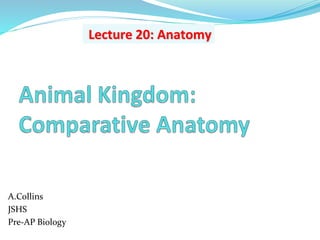
lecture_20_anatomy.ppt
- 1. A.Collins JSHS Pre-AP Biology Lecture 20: Anatomy
- 2. Section 26-1 have are carry out with such as What do animals do to survive? All Animals Feeding Respiration Circulation Excretion Response Movement Reproduction Eukaryotic cells Heterotrophs Essential functions No cell walls
- 3. Invertebrate feeding and digestion Invertebrates can either have intracellular or extracellular digestion: Intracellular meaning that food is digested within each individual cell of the organism. Examples: Sponges Extracellular means that digestion occurs inside a digestive tract or cavity, then absorbed into the body. Examples: mollusks, worms, arthropods, echinoderms
- 5. The digestive systems of many vertebrates have organs that are well adapted for different feeding habits. Carnivores, such as sharks have short digestive tracts that produce fast-acting digestive enzymes. Herbivores have long intestines that have large colonies of bacteria that help in digesting the cellulose fibers in plant tissues. Vertebrate Digestive Systems
- 6. Section 33-3 Esophagus Stomach Intestine Liver Gallbladder Pancreas Cloaca Crop Gizzard Cecum Rectum Shark Salamander Lizard Pigeon Cow The Digestive Systems of Vertebrates
- 7. Aquatic invertebrates Aquatic animals have natural moist respiratory surfaces, and some respire through diffusion through their skin and others use gills. There are many different respiratory specialized organs in terrestrial invertebrates. Spiders use parallel book lungs Insects use openings called spiracles where air enters the body and passes through a network of tracheal tubes for gas exchange Snails have a mantel cavity that is lined with moist tissue and an extensive surface area of blood vessels. Terrestrial Invertebrates Respiration in animals
- 8. Section 29-2 Mollusk Insect Spider Gill Siphons Movement of water Book lung Airflow Tracheal tubes Spiracles Invertebrate Respiratory Systems
- 9. Vertebrate respiratory systems Chordates have one of two basic structures for respiration: Gills – for aquatic chordates Example: tunicates, fish and amphibians Lungs - for terrestrial chordates Examples: adult amphibians, reptiles, birds, and mammals
- 10. Aquatic Gills Water flows through the mouth then over the gills where oxygen is removed Carbon dioxide and water are then pumped out through the operculum Section 33-3 Salamander Lizard Pigeon Primate Nostrils, mouth, and throat Trachea Lung Air sac Vertebrate Lungs
- 11. Open circulatory systems Blood is pumped through a system of vessels BUT is only partially contained in these vessels. Most of the time the blood is pumped through open cavities. This system is beneficial to arthropods and mollusks because the blood comes into direct contact organs and tissues. A closed system forces blood through vessels that extend throughout the body of the organism. Since the system is “closed” the blood never leaves the vessels. This system is beneficial to larger organisms because the blood is kept at a higher pressure which allows for more efficient circulation within the organism. Closed circulatory systems Invertebrate circulatory system can range from a system where cells simply do diffusion to take in oxygen or systems with many hearts and even systems with one heart. Invertebrate Circulatory systems
- 12. Section 29-2 Insect: Open Circulatory System Annelid: Closed Circulatory System Heartlike structures Blood vessels Heartlike structure Small vessels in tissues Blood vessels Hearts Heart Sinuses and organs Invertebrate Circulatory Systems
- 13. Vertebrate circulatory systems Chordate circulatory systems range from a single loop system (found in organisms with gills) to double loop systems. Double-Loop Circulatory System Single-Loop Circulatory System FISHES MOST REPTILES CROCODILIANS, BIRDS, AND MAMMALS
- 14. Aquatic Invertebrate excretion Some aquatic invertebrates simply diffuse ammonia out their bodies into the surrounding water where it is diluted and carried away. Example: sponges, cnidarians, and some round worms. Other aquatic invertebrates swell up with water, dilute the wastes and excrete the wastes through tiny pores in their skin. Terrestrial Invertebrate excretion Many terrestrial invertebrates convert ammonia into urea. Urea is a simpler nitrogenous compound that is much less toxic than ammonia. This urea is eliminated from the body in urine
- 15. Section 29-2 Annelid Arthropod Flatworm Malpighian tubules Digestive tract Nephridia Excretory pore Excretory tubule Flame cell Flame cells Excretory tubules Nephrostome Invertebrate Excretory Systems
- 16. Vertebrate Excretion Aquatic vertebrates kidneys and rely on gill slits to release excretory wastes into surrounding water for dilution. Terrestrial vertebrates rely on the kidney’s to filter out the ammonia and change it into urea and send it to be released in urine.
- 17. Nervous system All animals respond to their environment through specialized cells called nerve cells. In most animals nerve cells hook together to form the nervous system. Nervous systems can range from fairly simple to extremely complex. The arrangement of nerve cells from phylum to phylum can be dramatically different.
- 18. Section 29-2 Ganglia Ganglia Brain Brain Arthropod Mollusk Flatworm Invertebrate Nervous Systems Vertebrate Nervous Systems